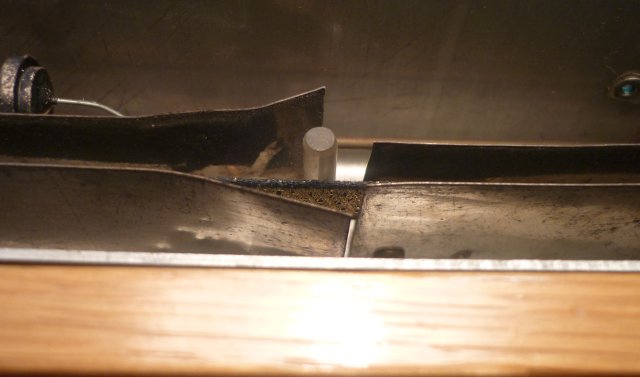Upon serveral requests I’ll show you the input devices of the Ondes Martenot today.
Except from the very early models that only had the ribbon controller, the instrument has two controls selectable by a switch.
One of them is a classical 6 octave keyboard (clavier) with rather small keys, the other is the ribbon controller (ruban) which the Ondes Martenot is famous for.
Le ruban
The function principle of the ribbon is that of a variable capacitor which makes up a variable oscillator with the addition of an inductor. By moving the ribbon by means of an attached finger ring along the keyboard, a metallized segment moves between several metal plates, one pair for each octave. With this construction the inventor has built six linear variable capacitors which are tied together via weighted capacitors, which in turn are connected to the LC tank circuit of the variable oscillator. The following image shows the circuit of the ribbon controller:
The ribbon is contacted by a brass roller and connected to ground by means of a LC tank circuit with adjustable capacitor and inductor. The analysis of the meaning of the circuitry will be part of the oscillator circuit description which I will post as soon as the restoration progress has reached this stage.
To compensate for the mismatching relationship between capacitance and the frequency slope within an octave, the capacitor plates are bent in a way that the ribbon position matches the note frequency of the key at the same position. Bending the plates with a pair of pliers is actually the only method the ribbon controller can be tuned! The next image shows a close up of the bent plates and the metallized ribbon passing in between:
Le clavier
When switched to keyboard mode, a ladder of fixed inductors becomes the frequency determining part of the oscillator. Depending on the key depressed, one or another node of the inductor ladder is grounded, resulting in a varying inductance influencing the oscillator’s frequency. Here’s the circuit of the first octave’s inductor ladder which is repeated in series connection for all six octaves:
The Ondes Martenot has a low-note priority, which means that whenever more than one key is pressed, the lowest note wins. Due to the circuit principle, there’s a positive proportionality between inductance and output frequency. While the oscillator frequency increases with decreasing inductance, the resulting beat frequency decreases – and vice versa. To achive this, the variable oscillators frequency must always be below the frequency of the fixed oscillator. With this configuration, the audible frequency (the difference between fixed and variable oscillator!) gets the lower the higher the variable oscillator …uhm… oscillates.
As you can see above, the inductor ladder is separated by some additional variable inductors. These are mounted to the keyboard, which is mounted floating with respect to the frame, and feature ferrite cores which are attached to the frame by wires. This allows for a vibrato effect by wiggling the pressed key and thereby the keyboard in its frame. The next photo shows one of those inductors:
The last photo shows the inductors for one whole octave:





